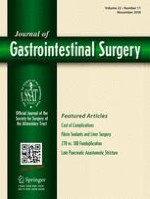01-11-2018 | Original Article
Specific Medicare Severity-Diagnosis Related Group Codes Increase the Predictability of 30-Day Unplanned Hospital Readmission After Pancreaticoduodenectomy
Published in: Journal of Gastrointestinal Surgery | Issue 11/2018
Login to get accessAbstract
Background
The Medicare Severity-Diagnosis Related Group coding system (MS-DRG) is routinely used by hospitals for reimbursement purposes following pancreatic surgery. We aimed to determine whether specific pancreatectomy MS-DRG codes, when combined with distinct clinicopathologic and perioperative characteristics, increased the accuracy of predicting 30-day readmission after pancreaticoduodenectomy (PD).
Methods
Demographic, clinicopathologic, and perioperative factors were compared between readmitted and non-readmitted patients at Brigham and Women’s Hospital following PD. Different pancreatectomy DRG codes, currently used for reimbursement purposes [407: without complication/co-morbidity (CC), 406: with CC, and 405: with major CC] were combined with clinical factors to assess their predictability of readmission. Univariate and multivariable analyses were performed to evaluate outcomes.
Results
Among 354 patients who underwent PD between 2010 and 2017, 69 (19%) were readmitted. The incidence of readmission was 13, 32, and 55% for patients with assigned DRG codes 407, 406, and 405, respectively (P = 0.0395). Readmitted patients were more likely to have had T4 disease (P = 0.0007), a vascular resection (P = 0.0078), and longer operative times (P = 0.012). On multivariable analysis, combining DRG 407 with relevant clinicopathologic factors was unable to predict readmission. In contrast, DRG 406 code among patients with N positive disease (P = 0.0263) and LOS > 10 days (P = 0.0505) was associated with readmission. DRG 405, preoperative obstructive jaundice (OR: 7.5, CI: 1.5–36, P = 0.0130), vascular resection (OR: 7.7, CI: 1.1–51, P = 0.0336), N positive stage of disease (OR: 0.2, CI: 0–0.9, P = 0.0447), and operative time > 410 min (OR: 5.9, CI: 1–32, P = 0.0399) were each strongly associated with 30-day readmission after PD [likelihood ratio (LR) < 0.0001].
Conclusions
Distinct pancreatectomy MS-DRG classification codes (405), combined with relevant clinicopathologic and perioperative characteristics, strongly predicted 30-day readmission after PD. DRG classification algorithms can be implemented to more accurately identify patients at a higher risk of readmission.





